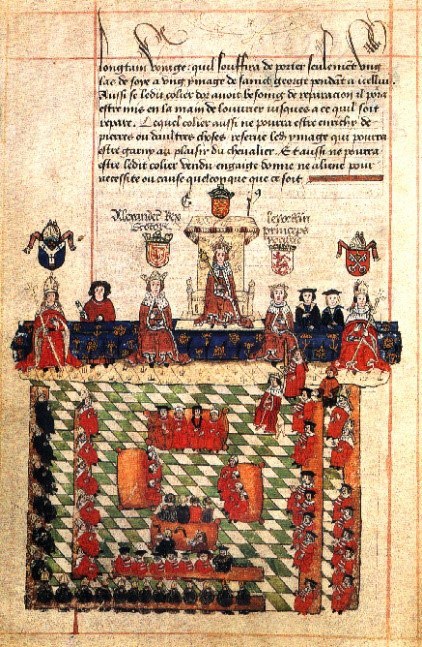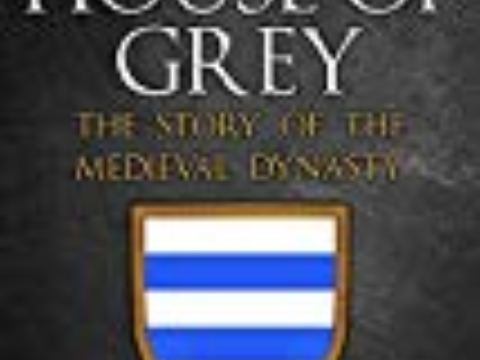Landholding in Tudor England
Chapter 1: Feudal Landholding
English land law was complex and arcane – it had built up over centuries, and much of it was based on the legal structure of feudalism which had gradually disintegrated since the Black Death in the mid-fourteenth century. This article, whilst it cannot be exhaustive, aims to outline the main principles of land holding, in England, and Wales after the Act of Union of 1536. It is not relevant to Scotland or Ireland.
When William the Conquer took England, he claimed outright ownership of all the land in the country. Obviously, he could not manage the entire country unaided, so he granted large tracts of land to his closest friends and advisors, and those who had helped with the invasion. These were the Crown’s tenants-in-chief, and were generally known as ‘barons’.
The tenants-in-chief did not own the land – they held it in return for specified services and they swore homage and fealty to the King, who, in turn, promised to protect them. According to the Domesday Book, William had 1,400 tenants-in-chief, amongst which the twelve most important secular tenants-in-chief held 54% of the land in England, whilst the King retained some 17% directly.
Only three of the tenants-in-chief were Saxon – Thokill of Warwick, Coleswain of Lincoln and Queen Aedyth, widow of Edward the Confessor. Judith of Lens, William’s niece, was also a tenant-in-chief, married to a Saxon Earl. These great land-holdings were known as ‘Honours’ eg, the ‘honour of Gloucester’. William carefully gave land in different geographic areas to prevent a single man having too much concentration of power in one location.
The tenant-in-chief held the land in return for ‘baron service’ – personal military support for the King, together with a specified number of knights and men-at-arms. He was also obliged to give counsel and advice to the King. The barons were the nucleus of what became Parliament. Whilst many of the barons also held land in France from the Norman, and later, the Angevin Kings, it became understood during the years following the Conquest, that military service was due only in the country where the land was held. It was also the general rule that the service would last for forty days, and, if the King wished to keep an army in the field thereafter, he would have to pay wages.
The tenants-in-chief retained some land for direct management – the demesne - then distributed the rest amongst the next level of landholder, who either held it in return for military service (knight-service) or, occasionally, in scutage, which was a commuted payment for knight-service. Some land might be held in fee simple – that is, with no obligations of service.
This pyramid structure was known as ‘sub-infeudation’. It was debatable whether lower ranking tenants owed fealty to the King, if their lord rebelled, but it was generally believed that the oath to his immediate superior was paramount.
Over time, Kings realised that sub-infeudation was creating layers of landholders with no direct accountability to the Crown or even his barons-in-chief and it was banned by the Statute of Westminster (Quia Emptores) 1290. A tenant who wished to alienate his land (that is, part with ownership of it) had to pass it on completely, in a public ceremony on the land itself, so that the new tenant replaced him and had to perform all his duties to his lord, rather than holding it from him. Quia Emptores also permitted barons to alienate land without royal permission.
The Feudal Manor
Sub-infeudation carried on down the chain until the lowest level of landholder who held a ’knight’s fee’ – that is the amount of land necessary to support a single knight, his family and servants. A knight’s fee, more or less interchangeable with the term ‘manor’, might range in size from 1,000 to several thousand acres, depending on the quality of the land. It might consist of a number of farms, mills, villages and buildings.
The rights and duties of all of the inhabitants of a manor were managed by the manorial court and there were various forms of tenure with greater or lesser degrees of freedom.
The manor lands might include some freemen, who generally paid money rents for land and were not subject to the fines and general oversight of their lives that the unfree had to deal with. Not surprisingly, lords frequently challenged a freeman’s status and it was not easy to prove.
The next category was the villein, who held land in return for agricultural service and some rent in cash or kind. Villein service was not usually full time, and they were free to sell any surplus from their own lands. A villein could not move to another manor without permission of both the old and new landlord.
Lower still were serfs. Serfs were tied to the manor, and if land were alienated the serf remained with it. They were not slaves, in that they could not be sold off the manor, but they needed the lord’s permission to marry. Serfs had their own fields, but owed more labour to the lord than a villein did. It was the lord’s duty to ensure that the serfs were protected from the depredations of robbers and that they were fed in times of famine. Slavery per se was outlawed by the Normans.
With the Black Death of 1348, and subsequent epidemics of plague, the population was reduced by as much as a half. In the face of this, the manorial system broke down, and villeins and serfs were in a position to bargain for better treatment. Although the Statute of Labourers of 1351 attempted to turn the clock back by forbidding people to leave their manors, or for lords to increase wages, it proved impossible to enforce, and by the mid-fifteenth century, serfdom and villeinage had all but disappeared. Most tenants on a manor held by copyhold – the terms of the holding were recorded in the manor’s rolls, and the land could be passed to the next generation if the appropriate payments were made.
One of the other consequences of the lack of labour following the Black Death was that landholders turned to sheep – sheep farming needed far less labour and by the mid-fifteenth century was proving extremely profitable. This created a long-term problem – as the population slowly began to recover, the landholders were not only unwilling to return the land to less valuable arable, but kept enclosing more. This was one of the great evils against which More warned in his book ‘Utopia’. It was also an underlying cause of the Pilgrimage of Grace, and the 1549 rebellions – with a growing population, less arable meant less food, and fewer jobs. Unemployment began to be a major social problem.







